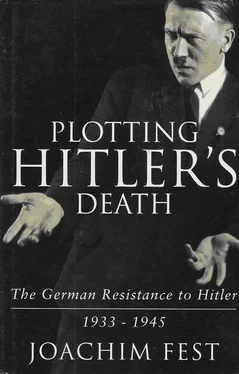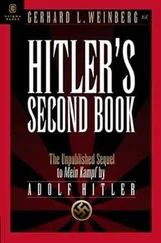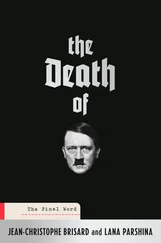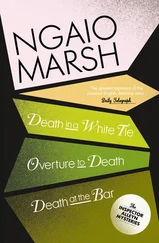The historian Gerhard Ritter has written that Stauffenberg had “a streak of demonic will to power and a belief that he was born to take charge” without which “the resistance was in danger of becoming bogged down in nothing but plans and preparations.” 22Once, when a member of the high command, appalled by the needless sacrifice of German soldiers and the staggering brutality being inflicted on the Soviet civilian population, asked Stauffenberg if it was possible to impress upon Hitler the truth of the situation, the young officer shot back, “The point is no longer to tell him the truth but to get rid of him,” a remark that sharply repudiated Goerdeler’s incurable optimism. 23At headquarters in Vinnitsa in October 1942 Stauffenberg spoke out openly before a gathering of officers about the “disastrous course of German policy in the East,” saying that everyone had remained silent even though it sowed hatred on all sides. Many witnesses have also reported his criticisms of generals who considered honor, duty, and service to be not binding ideals but simply grounds for making excuses; one report speaks of his contempt for all the “carpet layers with the rank of general. 2I
Stauffenberg’s entry into resistance circles caused an enormous shift in the distribution of power and influence without his doing anything in particular. It was inevitable that he would spark conflicts as well as hopes. Goerdeler and his close associates were particularly vexed by the eclipse of the civilian groups, which they felt should dominate the resistance, and began to mutter derisively about Stauffenberg’s lofty political ambitions and vaguely socialist tendencies. Soviet and East German historians later turned this grumbling to their advantage by depicting Stauffenberg as having moved close to Moscow in his political sympathies. But this myth, its somewhat grotesque origins, and the intentional exaggerations it underwent have all been investigated and disproved. 25
What is clear is that Colonel Stauffenberg was far from the flunky whom the sell-confident Goerdeler had always expected and previously always found in his collaborators from the military. In Stauffenberg a far more politically minded officer stepped forward, one who had no intention of simply putting himself at the beck and call of some group and its “shadow chancellor.” What distinguished Stauffenberg from Goerdeler was less the former mayor’s conservative, bourgeois values than his reluctance to employ violence and his rationalist delusion that Hitler could be made to see the error of his ways. Stauffenberg considered this as far-fetched as the highly contemplative opposition shared by many in the Kreisau Circle, which he derided as a “conspirator’s tea party.” As the man who would soon lead the actual coup attempt, he almost inevitably found himself at odds with both groups of conspirators, although for different reasons. On the whole, he felt closest to Julius Leber, the undogmatic Social Democrat with whom he shared the realistic political views and normative pragmatism of a man of action.
* * *
In early September 1943 Stauffenberg and Tresckow set about revising Olbricht’s plans for a coup once again, with an eye to correcting the inadequacies that had become apparent during the March attempt. Ironically, the original plans were based on a strategy that had been designed by Olbricht’s staff and approved by Hitler for dealing with “internal disturbances”—that is, an uprising by the millions of so-called foreign workers in Germany, possibly at the instigation or with the help of the Communist underground or enemy paratroopers. Under the code name Operation Valkyrie, the diffuse, scattered elements of the “reserve army”—trainees, soldiers on leave, and training staff and cadres-would immediately be united and transformed into fighting units. After the experiences of March Olbricht developed a second stage of this plan and had it approved in late July 1943. Henceforth “Valkyrie I” designated a strategy to ensure the combat readiness of all units and “Valkyrie II” provided for their “swiftest possible assemblage” into “battle groups ready for action.”
Tresckow and Stauffenberg hit upon what many have called the “brilliant” idea of further tailoring these official plans, which Olbricht apparently considered adequate, to the specific needs of a coup by adding a secret declaration, to be issued immediately upon Hitler’s assassination. It would begin: “The Führer Adolf Hitler is dead! A treacherous group of party leaders has attempted to exploit the situation by attacking our embattled soldiers from the rear in order to seize power for themselves!” The Reich government, the announcement continued, had “declared martial law in order to maintain law and order.” Simultaneously, government ministries and Nazi Party offices would be occupied, as would radio stations, telephone offices, and the concentration camps. SS units would be disarmed, and their leaders shot if they resisted or refused to obey.
Thus the conspirators succeeded in standing Operation Valkyrie, and the plan for dealing with “internal disturbances,” on its head. Stauffenberg and Tresckow’s additional declaration would pin the blame for the uprising that they themselves were staging on the Nazi Party, a strategem intended to pacify those who would probably oppose the coup if they knew the true situation. The entire plan to overthrow the regime, therefore, depended on an enormous hoax carried out in large part by scores of officers and troops obliviously following orders.
Since the success of the undertaking relied considerably on the element of surprise which, in turn, would set in motion blind adherence to the automatic chain of command-secrecy was of the essence. All written information was handled by Tresckow’s wife, Erika, and by Margarete von Oven, who had been Hammerstein’s secretary during his days as chief of army command. Both women wore gloves when they worked so as not to leave fingerprints. All meetings were held out of doors at various locations in the Grunewald, but they often had to be canceled and then, with great difficulty, rescheduled because of Allied air raids, breakdowns in public transportation, or other unforeseeable events. One evening a group of conspirators were returning from one of their meetings in the Grunewald when an SS van came screeching to a halt directly beside them on Trabenerstrasse. Margarete von Oven was carrying all the documents about the uprising under her arm, and “when the SS men poured out, each of them thought the conspiracy had been discovered and they would be arrested at once. But the SS men paid no attention to the three passersby and disappeared into a house.” 26
Despite the conspirators’ efforts, the Valkyrie plan had a serious and possibly fatal flaw: neither Olbricht nor Stauffenberg was authorized to order its implementation. Hitler had expressly reserved this authority for himself, with the commander of the reserve army, General Friedrich Fromm, authorized to give the cue only in an emergency. Therefore Olbricht or Stauffenberg had either to win Fromm over or else to usurp his position and set Valkyrie in motion in his name. Olbricht was prepared to take Fromm into custody if necessary and sign the orders himself, but that risked questions about the chain of command and delays that might imperil the entire enterprise. It has also been pointed out rightly that this was a tactic that could work only once. If the conspirators failed to usurp Fromm’s position “the first time around, there would be no second chance.” 27
General Fromm was a large, shrewd man who liked to boast that he “always came down on the right side.” When Halder asked him earnestly in the fall of 1939 to support the generals’ coup that was being plotted, Fromm evaded the issue at first and then requested lime to consider the matter. He was torn by doubts about the chances of success and tormented by the fact that he had compromised himself by responding to Halder at all. Finally he formally absolved himself of involvement by recording the affair in his official diary.
Читать дальше




![Traudl Junge - Hitler's Last Secretary - A Firsthand Account of Life with Hitler [aka Until the Final Hour]](/books/416681/traudl-junge-hitler-s-last-secretary-a-firsthand-thumb.webp)







